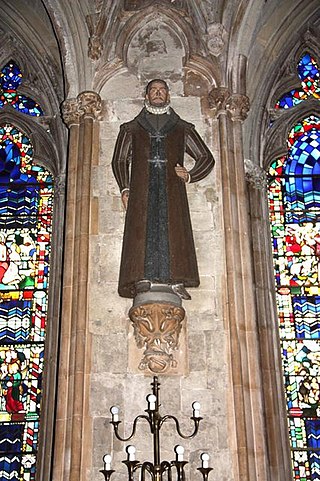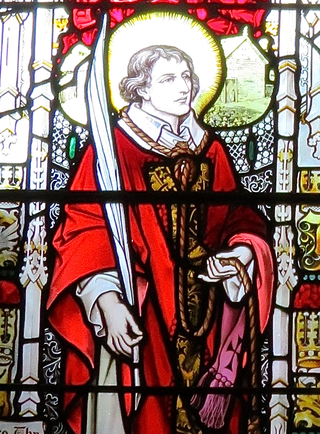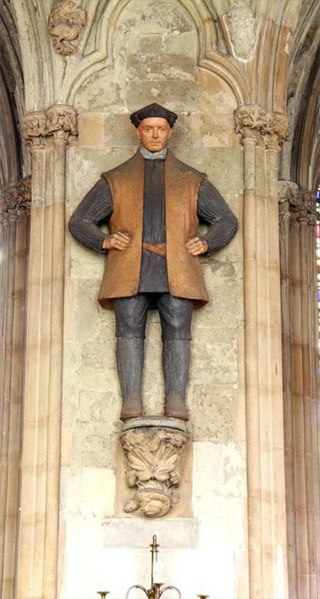
Richard Challoner was an English Catholic prelate who served as Vicar Apostolic of the London District during the greater part of the 18th century, and as Titular Bishop of Doberus. In 1738, he published a revision of the Douay–Rheims Bible.
The Dryburne Martyrs: Richard Hill, Richard Holiday, John Hogg and Edmund Duke were English Roman Catholic priests and martyrs, executed at Dryburne, County Durham, in the reign of Elizabeth I. They were beatified by Pope John Paul II in 1987.

Richard Gwyn, also known by his anglicized name, Richard White, was a Welsh teacher at illegal and underground schools and a bard who wrote both Christian and satirical poetry in the Welsh language. A Roman Catholic during the reign of Queen Elizabeth I of England, Gwyn was martyred by being hanged, drawn and quartered for high treason at Wrexham in 1584. He was canonized by Pope Paul VI in 1970 as one of the Forty Martyrs of England and Wales. Since its creation in 1987, St. Richard Gwyn has been the Patron Saint of the Roman Catholic Diocese of Wrexham. Along with fellow lay martyr St. Margaret Clitherow, Gwyn is the co-patron of the Latin Mass Society of England and Wales.
Richard Leigh was an English Roman Catholic martyr born in Cambridge, the scion of Cheshire gentry, squires of the West Hall, High Legh since the 11th century.

Swithun Wells was an English Roman Catholic martyr who was executed during the reign of Elizabeth I. Wells was a country gentleman and one time schoolmaster whose family sheltered hunted priests. He himself often arranged passage from one safehouse to another. His home in Gray's Inn Lane was known to welcome recusants.

Edward James was an English Catholic priest and martyr.

John Roche was a Catholic martyr, born in Ireland, who died in London, England on 30 August 1588.

The Eighty-five Martyrs of England and Wales, also known as George Haydock and Eighty-four Companion Martyrs, are a group of men who were executed on charges of treason and related offences in the Kingdom of England between 1584 and 1679. Of the eighty-five, seventy-five were executed under the Jesuits, etc. Act 1584.
Ralph Crockett was an English Roman Catholic priest. He is a Catholic martyr, beatified in 1929.
John Finglow or Fingley was an English Roman Catholic priest. He is a Catholic martyr, beatified in 1987.
Edward Stransham was an English Roman Catholic priest. He is a Catholic martyr, beatified in 1929.
William Hartley was an English Roman Catholic priest. He is a Catholic martyr, beatified in 1929.
John Hewitt or Hewett (date of birth unknown; executed at Mile End Green, 5 October 1588) was an English Roman Catholic priest. He is a Catholic martyr, beatified in 1929.
Richard Sergeant (executed at Tyburn, 20 April 1586) was an English Roman Catholic priest. He is a Catholic martyr, beatified in 1987.
William Dean or Deane was an English Roman Catholic priest. He is one of the Catholic martyrs, beatified in 1929.

The Oaten Hill Martyrs were Catholic Martyrs who were executed by hanging, drawing and quartering at Oaten Hill, Canterbury, on 1 October 1588. The gallows had been put up in 1576. These four were beatified by Pope Pius XI in 1929.
Thomas Holford (1541–1588) was an English Protestant schoolteacher who became a Catholic priest during the reign of Queen Elizabeth I. He was martyred at Clerkenwell in London, and is recognised by the Catholic Church as having the status of Blessed.
Richard Martin was an English martyr. A layman, Martin was charged with being a "receiver and maintainer of priests" for having bought supper for Robert Morton, a priest.
Nicholas Woodfen born Nicholas Wheeler, also known as Nicholas Devereux, was an English Roman Catholic priest who was hanged, drawn and quartered at Tyburn, London on 21 January 1586. He is considered a Catholic martyr and one of the Eighty-five martyrs of England and Wales who were executed between 1584 and 1679. He was beatified on 22 November 1987 by Pope John Paul II.







